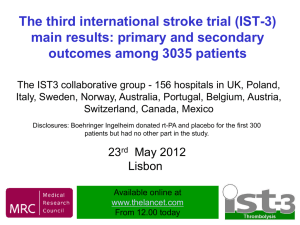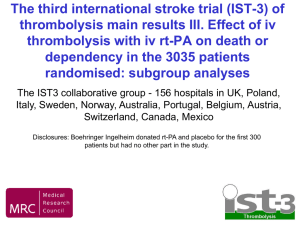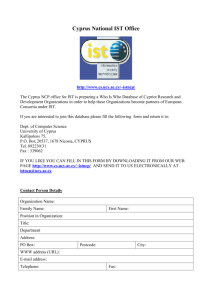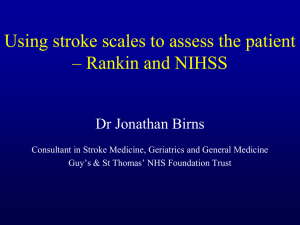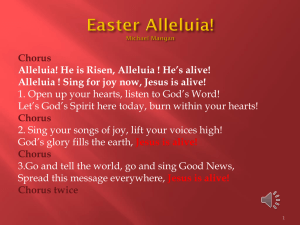IST-3: What are the implications for rt-PA therapy?
advertisement
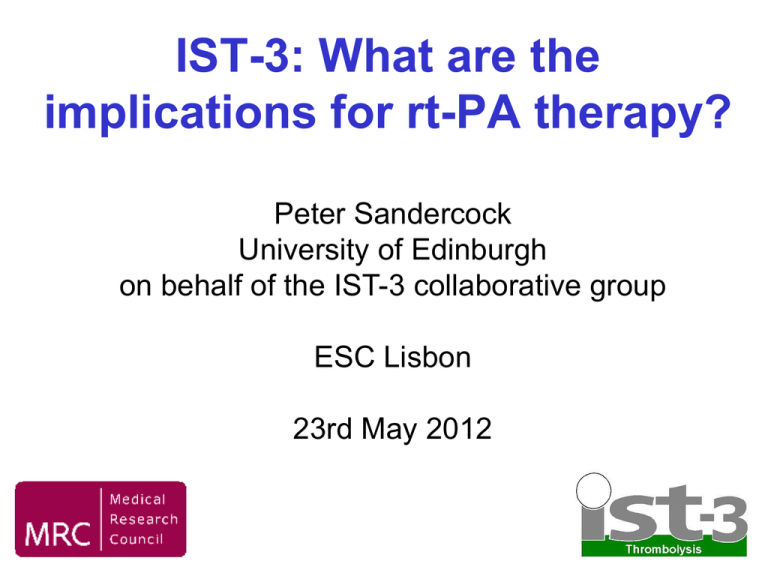
IST-3: What are the implications for rt-PA therapy? Peter Sandercock University of Edinburgh on behalf of the IST-3 collaborative group ESC Lisbon 23rd May 2012 Disclaimer & disclosures • I will present relevant data from current research and there may be data or statements not covered by current regulatory approval. This presentation does not suggest clinical use beyond regulatory approval. • Please always check the most current prescribing information as approved for your country. • IST-3 was conducted completely independently. BI donated drug and placebo for the first 300 patients in IST-3 and thereafter made no financial contribution, & had no role in data collection, analysis, reporting or the decision to publish. • IST-3 disclosures in full in Lancet publication Baseline characteristics1 (n=3035) • 849 (28%) randomised < 3 hours • 1617 (53%) aged > 80 years • 1305 (43%) TACI syndrome • 970 (32%) baseline NIHSS > 16 • 914 (30%) in AF • 95% did not meet EU approval for rt-PA • Treatment and control groups balanced on all key factors 1.Trials 2011, 12:252. http://www.trialsjournal.com/content/12/1/252 Time to randomisation and age 1400 1200 Number 1000 800 <80 yrs >80 yrs 600 400 200 0 0-3 3-4.5 4.5-6 Time to randomisation (hrs) Number Stroke severity: 970 (32%) NIHSS > 16 900 800 700 600 500 400 300 200 100 0 0 to 5 6 to 10 11 to 15 16 to 20 21 to 35 NIHSS Safety: Fatal & non-fatal intracranial haemorrhage < 7 days rt-PA (n=1515) n (%) 104 (7%) Control (n=1520) n (%) 16 (1%) P < 0.0001 applying the ‘Cochrane’ definition, of SICH, the 7% IST-3 frequency is comparable with the 7.3% (SITS) registry of 6483 patients treated within licence in routine clinical practice1 1. Wahlgren, Lancet 2007; 369: 275–82 Overall - all patients 0-6 hrs: ‘alive and independent’ (OHS 0-2) rt-PA (n=1515) n (%) 554 (37%) control (n=1520) n (%) 534 (35%) Absolute difference/1000 = 14 more alive and independent (95% CI -20 to 48) NS Overall: 6 month OHS Favourable shift; adjusted common odds ratio 1·27 (95% CI 1·10- 1·47), p=0·001 Ordinal will be more statistically efficient than primary outcome for subgroup analysis Focus on early treatment Time (hours) from stroke to randomisation 0-3h 3-4.5h 4.5-6h Age <80 177 558 683 Age >80 672 620 325 849 1178 1008 All Subgroups: adjusted effect on primary outcome: ‘alive and independent’ (interaction) The treatment odds ratio in each subgroup has been adjusted for the linear effects of the other key variables At six months, for every 1000 patients treated with rt-PA All ages 0-6 hrs 14 more alive and independent (NS) 29 more ‘favourable outcome’ (p=0·018) Favourable shift in OHS (p=0.001) No difference in deaths In patients > 80 years 0-6hrs 38 more alive and independent In patients all ages < 3hrs 80 more alive and independent One thing that the IST-3 results cannot do is reaffirm or refute prior trials of thrombolytic therapy… Stroke 2012; 43; May 3 (online) Effect on ‘alive and independent’ (OHS/mRS 0-2) among patients < 3hrs IST-3 does affirm the benefits of Early treatment < 3hrs Implications for practice. IST-3 enables clinicians to: • Consider thrombolytic treatment for a wider variety of patients, – Particularly those aged over 80 years – With more severe strokes • Reinforce their efforts to increase the proportion of ischaemic strokes treated < 3 hours • Have greater confidence that mortality is not increased by treatment Implications for research • The data strengthen the rationale for the ongoing trials of thrombolysis among patients presenting more than 4.5 hours after onset • Need for the planned STTC individual patient data meta-analysis to determine which characteristics (other than age & time) identify who is most likely to benefit • The imposition of upper age limits on future trials in acute stroke will become harder to justify. Acknowledgements: The 3035 patients, the 156 hospitals in the IST-3 group, the Data Monitoring Committee, the MRC Steering Committee, Image Reading Panel, Event adjudication panel, International Advisory Board. Funding: Medical Research Council (managed by NIHR on behalf of the MRC-NIHR partnership), Stroke Association, The Health Foundation,, The Research Council of Norway, AFA Insurances (Sweden), the Swedish Heart Lung Fund, The Foundation of Marianne and Marcus Wallenberg, Stockholm County Council and Karolinska Institute Joint ALF-project grants (Sweden), the Government of Poland, the Australian Heart Foundation, Australian NHMRC, the Swiss National Research Foundation, the Swiss Heart Foundation, the Foundation for health and cardio/neurovascular research, Basel, Switzerland and the Assessorato alla Sanita, Regione dell'Umbria. Drug and placebo for the 300 patients in the double-blind component of the start-up phase were supplied by Boehringer-Ingelheim GMBh. IST-3 acknowledges the extensive support of the NIHR Stroke Research Network , NHS Research Scotland (NRS), through the Scottish Stroke Research Network, and the National Institute for Social Care and Health Research Clinical Research Centre (NISCHR CRC). The imaging work was undertaken at the Brain Imaging Research Centre, a member of the SINAPSE collaboration, at the Division of Clinical Neurosciences, University of Edinburgh. SINAPSE is funded by the Scottish Funding Council (SFC) and the Chief Scientist Office of the Scottish Executive (CSO). Additional support was received from Chest Heart and Stroke Scotland, Desacc, University of Edinburgh, Danderyd Hospital R&D Department, Karolinska Institutet, the Dalhousie University Internal Medicine Research Fund. Follow-up at 6 months rt-PA (n=1515) Placebo (n=1520) 11 13 Alive, disability imputed 31 41 Known disability status 1473 1466 No· for analysis (OHS known or imputed) 1515 1520 Status at six months Not known dead/alive Vital status known for 3011/3035 = 99.2% Kaplan-Meier survival rt-PA Control
